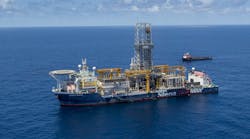How extensive will be the U.S. refining sector's shakeout spawned by the Clean Air Act?
Kidder Peabody estimates U.S. refiners will have to invest $1,500-3,000/b/d of capacity to make reformulated gasoline and ultralow sulfur diesel as mandated by CAA. Because many refineries are too small to manage this investment, as much as 1-2 million b/d of capacity will shut down by 1994, the analyst warns.
Kerr-McGee is another such U.S. refiner facing the tough decision of which plants to shut down and which to keep open and invest in.
Last week it hired Morgan Stanley to help it assess options for its refining/marketing subsidiary, including sale, continuing as is, expansion, or restructuring. Kerr-McGee has a 43,000 b/d refinery at Wynnewood, Okla., a 104,000 b/d refinery in Corpus Christi, Tex., an 8,000 b/d specialty solvents refinery in Cotton Valley, La., wholesale terminals and retail sales east of the Rockies, and a lubes/grease business.
Until capacity rationalization works its way through the system, U.S. refiners won't enjoy robust financial health, says Kidder Peabody. Once that and full economic recovery occur, it contends, the biggest refiners will have increased market share and sometimes improved product pricing power.
Pessimism over near term financial health of U.S. refining is under-scored by recent data on industry fundamentals.
Merrill Lynch points to a continuing trend of weak industry performance, noting that U.S. gasoline stocks should be about 13 million bbl lower than they are in order to ensure healthy refining margins.
There's good news, however, for U.S. refiners concerned about a possible shortfall of MTBE supplies, a critical factor in meeting the demand for CAA spec gasoline. BP and Mobil are developing a new cost-effective process for producing feedstocks for oxygenates, including MTBE. The process involves converting a common linear hydrocarbon such as normal butene to a more reactive form using a proprietary Mobil zeolite catalyst. The technology is expected to sharply jump production of MTBE from refinery butenes.
Once again, the House appropriations committee has voted to deny Interior funds to plan for certain offshore lease sales, effectively blocking them. The bans in the Interior appropriations bill would block leasing off the East Coast, off Florida south of 26 N. Lat., off the Lower 48 West Coast, and in Alaska's Bristol Bay. The bill goes to the House floor soon.
U.S. Ex-Im Bank has approved credit guarantees to support oil and gas development in Venezuela. It will guarantee $522.5 million of a $632.9 million loan to Bariven SA to buy U.S. oil goods and services and a $10.2 million loan to support ABB Lummus Crest's $12 million sale of electrical and piping equipment to Resilin CA, a joint venture of Pequiven, Combustion Engineering, and Banco Latino, to build a low density polyethylene plant at the El Tablaza petrochemical complex in Maracaibo.
Lower than expected oil prices have led Venezuela to trim expectations of 1992 oil export earnings to $10.9 billion from an earlier estimate of $13.5 billion. The government projects 1992 exports of crude and products at 2.1 million b/d at an average price of $14.30/bbl vs. its earlier estimate of $19. Despite earlier concerns over excessive foreign borrowing, Pdvsa now has a green light to seek export credits and other types of international financing to cover part of its 1992 capital needs. Pdvsa Pres. Gustavo Roosen was in New York in mid-June discussing financing options with international banks. In April, Pdvsa's foreign debt was $2.17 billion, compared with $923 million owed Venezuelan commercial banks.
Texaco has joined the list of companies considering buying an interest in the $5.2 billion (Canadian) Hibernia project off Newfoundland. Canadian Energy Minister Jake Epp says he is optimistic Ottawa can wrap up a deal with Texaco by early fall. Gulf Canada pulled out of the project earlier this year, forcing a slowdown in development to a 1997 start-up.
Hyundai recently was reported as a potential buyer of Gulf's interest but has not confirmed that report (OGJ, June 29, Newsletter).
There is still a work force of about 2,000, with about 750 working on design and engineering for topsides for an offshore production platform. The rest are working at the Bull Arm site, where a concrete base and module will be built. Base constructor Newfoundland Offshore Development Constructors says the site is ready and other work can be quickly accelerated.
Australia's BHP is solidly confirming its presence as a major player on the global E&P scene.
It plans to spend $3.7 billion (Australian) on oil and gas projects the next 7 years, including Australia's Northwest Shelf and Bass Strait, Papua New Guinea, U.K. North Sea, and U.S. Gulf of Mexico. This year, the company will boost exploration spending to $300 million from $285 million.
Taiwan's Chinese Petroleum Corp. continues to expand its international influence. CPC is mulling an Angolan proposal for a joint venture covering oil exploration off Angola, says Du Ling, director of the African affairs department of Taiwan's ministry of foreign affairs.
China plans its first round of international bidding for exploration acreage in the East China Sea. The acreage covers 18,800 sq km in the northern part of the sea 230 km east of Shanghai and 54,000 sq km in the southern part of the sea east of Wenzhou. Water depths are 50-100 m. China has conducted 60,000 line km of seismic, drilled five wildcats, and found two oil and gas fields in the region. Plans are under way to lay a pipeline from the fields to Shanghai. China National Offshore Oil Corp. is offering sweeter financial terms than in previous rounds. Bid deadline is July 1993, with exploration expected to start in 1994.
The C.I.S. is experiencing yet another gas pipeline shutdown in the trans-Caucasus area. North Ossetia recently closed a pipeline from Russia to Georgia, which still receives small volumes of gas from Azerbaijan.
Gas deliveries to Armenia remain cut off by Azerbaijan, which is engaged in military clashes with Armenia. Meanwhile, Ukraine says it is ready to negotiate new gas prices with Turkmenistan, which stopped gas pipeline deliveries to Ukraine earlier this year.
Hungary's MOL plans to bid for concessions in Algeria, Nigeria, and the C.I.S. in its search for gas to supply the country's consumption of about 1 bcfd, OPEC News Agency (Opecna) reports.
MOL's Janos Szito, head of foreign ventures, says the company has developed its expertise and is now ready to enter the international arena. Because MOL's expertise mostly involves onshore drilling, it is seeking partners to bid for offshore acreage.
Middle East nations are accelerating oil and gas development while lining up supply deals with Far East nations.
On the heels of a long term LNG supply agreement with Japan, Qatar has received a firm request from South Korea to supply 2 million tons/year of LNG. Opecna reports negotiations are continuing and the deal is to close by yearend. Ambassador to Qatar Nae Hyong-Yoo says South Korea will need more than 9 million tons/year of LNG by 2000, and by the time Qatar is ready for LNG exports in 1997, South Korea's demand will have reached 6-7 million tons/year. South Korea is trying to diversify LNG sources and agreed to purchase 2 million tons/year from Indonesia as well additional supplies from Malaysia.
Oman wants to step up development of its gas industry, seeking to establish enough reserves for 50 years of domestic consumption and for a $9 billion project to export LNG to Japan (OGJ, Feb. 17, p. 34). Gas reserves are pegged at 17 tcf. Middle East Economic Survey reports Oman has begun talks with Iran about developing West Bukha and Henjam fields in the Persian Gulf, where natural gas and liquids reserves have been found. Talks are also under way with Qatar about importing Qatari gas to use either in joint ventures with Qatar or in setting up gas based industries on its own.
Oman plans to hike its oil production to 750,000 b/d this year from its current level of about 720,000 b/d, Opecna reports. But the country is willing to cut output in support of market stability, says Petroleum and Minerals Minister Said Bin Ahmad Al-Shanfari. Plans call for maintaining the higher level the next 10 years, made possible by boosting oil reserves to about 4.55 billion bbl in 1991 via discovery of 174 million bbl.
Meantime, the Saudi-Japanese joint venture project to refine 450,000 b/d in Japan and 300,000 b/d in Jubail (OGJ, Jan. 20, p. 22), has been delayed for further talks, reports Saudi Gazette.
Copyright 1992 Oil & Gas Journal. All Rights Reserved.

